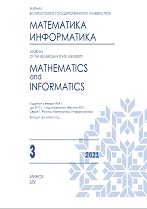|
Theoretical foundations of computer science
A steganographic method of embedding an identifier into the spatial data of an electronic map
E. A. Blinovaa, I. Yu. Stashevskayaa, P. P. Urbanovichab
a Belarusian State Technological University, 13a Sviardlova Street, Minsk 220006, Belarus
b The John Paul II Catholic University of Lublin, 14 Racławickie Alley, Lublin 20-950, Poland
Abstract:
Electronic maps (e-maps), which are a set of computer files, are the main form of representation of geographic information to the end user. An important task is protecting e-maps from unauthorised use or modification. This paper describes the steganographic method of embedding an invisible digital watermark into the spatial data of e-maps for protecting copyright, ensuring integrity of maps or proving their authenticity. The method is applicable to e-maps in the Shapefile and GeoJSON formats. It is based on the placement of additional points in spatial objects (polygons) of the
e-map. In this case the e-map is used as a carrier object, and point coordinates are elements of the key information of the steganographic transformation. This establishes a relationship between the spatial objects of the e-map, which ensures their integrity. Algorithms for direct and inverse steganographic transformations are considered. The developed StegoMap Internet service for implementing the placement and extraction of an invisible digital watermark on the basis of the proposed method is described.
Keywords:
e-maps; steganography; copyright; digital watermark; spatial data; GeoJSON format; Shapefile format.
Received: 15.12.2022
Revised: 16.02.2023
Accepted: 21.03.2023
Citation:
E. A. Blinova, I. Yu. Stashevskaya, P. P. Urbanovich, “A steganographic method of embedding an identifier into the spatial data of an electronic map”, Journal of the Belarusian State University. Mathematics and Informatics, 1 (2023), 76–87
Linking options:
https://www.mathnet.ru/eng/bgumi409 https://www.mathnet.ru/eng/bgumi/v1/p76
|

| Statistics & downloads: |
| Abstract page: | 84 | | Full-text PDF : | 30 | | References: | 22 |
|




 Contact us:
Contact us: Terms of Use
Terms of Use
 Registration to the website
Registration to the website Logotypes
Logotypes








 Citation in format
Citation in format 